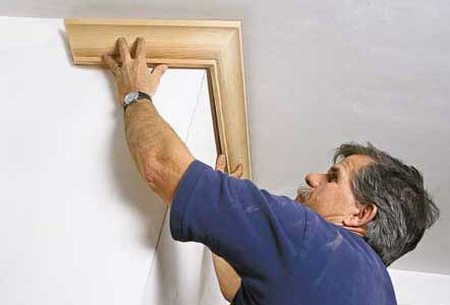Want to add some elegance and flair to room? Crown mold will be the trick in hurry. Working the overhead can be bit tiring, but results are very dramatic. Try to add crown moldings to home and see it does for you. May be it is just final touch missing for perfect home.
- Measure the linear footage required to span distances to be trimmed. Then add 10 percent to its figure for the waste and mistake.
- Select a style and finis your new crown mold. There are several shapes and the sizes available.
- Pick up a style which suits decor and your personal taste. Finish you put on is to be purchased and then applied before you have to start any cutting or fitting.
- Try buying trim in lengths which needs a few splices possible. In few cases splices all are unavoidable but fewer there are better finished job would look.
- Stain else paint the molding and allow to dry thoroughly.
- Trimming work is easy and more accurate also with comfortable place for work. This should have of a long bench set up at comfortable height.
- Cutting needed angles for corners of trim is handled by most accurately with miter saw.
- Set work station where the power is readily accessible with plenty of light.
- Work over head is tiring also awkward; a solid work platform makes work much safe and easy. Use heavy plank and also two sturdy saw horses or rent scarf folding on wheels by using as platform to stand while installing molding.
Trimming with Joining
- Over come not-quite-a square corners? Most of them all are not squares. With “coped” joints
- Run first piece of a crown molding tightly in to corner. Cope cut second piece which forms other leg of corner angle in shape of profile of molding such that it butts neatly against face of first piece. Here is how:
- Use deep miter box with a fine tooth saw to make cut that reveals profile of molding. Position molding such that it is up side down in miter box. Face of molding that is against ceiling will lie on bottom of miter box. Remember that for in side corners, bottom of crown mold will be longest edge.
- Cutting proper miter reveals profile of molding. Cut away excess wood along back side of mold following profile line with coping saw. Errs on side of removing much rather than little; only outermost edge of coped mold will be seen.
- Use utility knife in removing any excess material missed with coping saw. But be careful of what you don’t cut in to exposed face of mold. Hold piece in place for testing the fit. Also take it down to do more carvings if necessary. This will at times take many fittings and also trimmings to get cleanest-fitting joint.
- Plan out job will help to save work also material. Work out pattern in which an end of each piece of the crown mold will be always cut in straight and other end will be mitered or coped. Use the scarf joint for long run where pieces meet, cut end at 45 degrees so they will overlap. Lay out work so joins are all on the top of stud. Save most visible parts of job for last, when you have honed coping skills.
